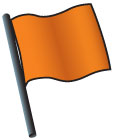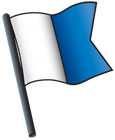Why Are Boating Flags Red, Blue, and White?

You may be flying a red, white, and blue American flag or a red and white Canadian flag on your boat, but those aren't the "boat" flags we're talking about today.
There are many different components to boating safety, and one of those is the flag system used to communicate with other boaters around you.
Boating flags come in several colors, and each color means something different. Many flags also have multiple colors or symbols on a solid-color background.
Boat flags communicate information to others or let them know there's a problem, and you need help. Since time can be of the essence in either of those situations, using the flags properly is vital. You don't want to waste time deciphering flag meanings when someone is injured or your boat is at risk.
While you'll see yellow and black on some flags, three primary colors used for flags in boating are red, blue, and white — but do you know why? We'll cover that topic today!

Red, Blue, and White
Understanding, recognizing, and using boating flags appropriately is crucial to enjoying safe adventures on the water.
These three colors — red, blue, and white — can be used individually through solid-color flag options or a combination of colors, such as a red and white boat flag. The most important thing you can do with these flags on your boat is understand what they mean and when to use them.
Choosing the wrong color or flag could send an incorrect message to other boaters and not get the help you need.
Historical Context for Boat Flags
Two areas related to historical context are:
- Maritime tradition
- The International Code of Signals.
Flags have been used in maritime navigation for decades because they are lightweight, easy to store, and easy to see from a distance. That made them a logical choice for boaters needing to share information.
The International Code of Signals standardized flag colors for universal understanding. That's particularly important in international waters and areas where countries' borders touch over waterways.
Since the colors are standard worldwide, every boater knows what they mean when they see them.

Symbolism and Meaning
Each flag has its meaning, and if you spend time on the water, it's important to know the flag colors and meanings to ensure proper boating safety.
- Red Flags: These flags indicate danger or warnings and can alert vessels to be cautious or avoid particular areas.
- Diver Down Flag: A red flag with a white diagonal stripe indicates a diver down, so other boats know there's someone under the water nearby.
- Blue Flags: These are for safety, permission, or attention requests. For example, the blue Q flag means a vessel is looking for clearance from port health authorities and is one of the "request" flags.
- White Flags: Traditionally, white flags are used for truce or surrender to indicate that the boat displaying the flag is not a threat.
Additionally, white flags can be used for communication or signaling. The Alpha Flag, white with a blue swallowtail, indicates that a vessel has divers down.

How Should You Use Flags When Boating?
Boating flags have several practical applications and can convey important information quickly and efficiently when used correctly.
On your boat, keep them where you can access them during an emergency. Many boaters keep their flags with their first aid kit, fire extinguishers, and other boating safety equipment.
Navigation and Safety
Like beacons, buoys, and lights, flags can be used in several scenarios to improve navigation and increase safety.
In regattas, for example, red flags indicate that a race has been canceled or postponed. Not only does using a red flag get attention, but it also shows there's a problem or something boaters need to be warned about.
Emergency Situations
Boat flags are crucial in emergency situations.
A blue distress flag, for instance, indicates that the boat needs assistance. That could be due to a mechanical failure, taking on water, an injured passenger, or several other reasons.
Color Visibility
Seeing the flag's color is a big part of helping boaters get noticed properly.
For example, a red and white boat flag has a good contrast against the water and sky and can be seen from a significant distance away. While blue flags may blend in more easily, they generally have stripes or symbols on them that help them stand out.
When you need to get the attention of other boats in the area, using the right flags can mean getting quick help for a serious situation. It also helps ensure that your divers stay safe or that other boats avoid a hazard you've discovered in the water.
These flags have so many uses, and they can convey a lot of valuable information to others.

Learn More About Boating Flags and Safety With BOATERexam
One of the best ways to learn more about boating flags and other essential safety considerations is to take a boater safety course before hitting the water this season. You'll learn about all the different aspects of operating your boat properly, and that can give you the confidence and peace of mind you need to enjoy your time on the water fully.
We want you to stay safe every time you head out on the water for another adventure. That's why our online BOATERexam courses present state-required safety knowledge in an engaging way so you're more likely to retain the information that could save lives while operating a boat.
So, before you head out again, make sure you have the safety knowledge you need to protect yourself and others. In Canada, take our Canada-approved course. For boaters in the U.S., choose the course for your state and start learning.



